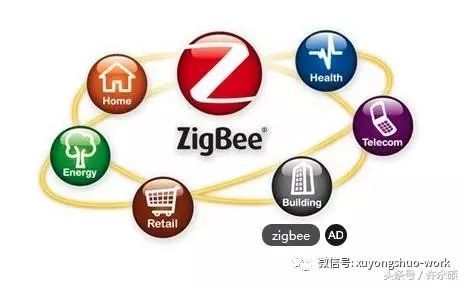This article is the content of IC Coffee Classroom 001 | IoT Group Micro Classroom’s fourteenth sharing session.
This time, we invited Mr. Zhang Min, Chairman of Yongmin Technology, to share about Zigbee technology and smart home.

Zigbee Technology and Features
Hello everyone, I would like to first share with you about “Zigbee technology and smart home”. Zigbee technology is a short-range, low-complexity, low-power, low-data-rate, and low-cost bidirectional wireless communication technology. It can operate in the 2.4GHz band, which is also a globally used frequency band. In Europe, there are 868MHz, and in the United States, there are 915MHz channels. When working in 2.4G, Zigbee technology can achieve a maximum transmission rate of 250KBps. The distance varies depending on the chip design capabilities of the manufacturer, with some capable of reaching about a hundred meters, while others can reach several hundred meters. Zigbee technology is currently one of the main practical technologies in the Internet of Things and smart home applications, alongside WiFi and Bluetooth, forming a rich and diverse wireless local area network technology for IoT applications.

The characteristics of Zigbee technology include low power consumption, low cost, low latency, high capacity, high security, self-organization, low data rate, and the ability to reach distances of over a hundred meters, using unlicensed frequency bands. Zigbee technology is currently the most secure technology in local area network technologies. The Zigbee solution, based on the widely praised Zigbee Pro mesh network protocol, possesses several new security features designed for today’s market and the ever-evolving risk environment. For instance, it includes security features initially developed for the Zigbee Smart Energy standard, which have been applied in hundreds of millions of smart meters worldwide, with no security vulnerabilities discovered to date.
Due to Zigbee’s relatively low transmission rate, limited bandwidth, milliwatt-level transmission power, and its use of sleep and idle modes, its power consumption is quite low. Therefore, Zigbee devices are very energy-efficient.
Zigbee’s network capacity is very large. A level one network can accommodate up to 254 slave devices and 1 master device. More than 100 Zigbee networks can coexist in a single network area, and the network configuration is flexible. Theoretically, a mesh network structure of Zigbee can have over 65,000 nodes.
Zigbee technology employs collision avoidance strategies and reserves dedicated time slots for communication services requiring fixed bandwidth, avoiding competition and conflict during data transmission. Its MAC layer uses an acknowledgment-based data transmission mode, where each data packet must wait for acknowledgment. If issues arise during transmission, retransmission can be requested, ensuring high reliability.
As mentioned earlier about high security, Zigbee provides a data packet integrity check function based on Cyclic Redundancy Check (CRC), supports authentication and authorization, and employs AES-128 encryption algorithms, allowing various applications to flexibly determine their security attributes.
One major feature of Zigbee is its self-organizing mesh capability. Its self-organizing function requires no manual intervention, as the network can sense the presence of other nodes and determine connection relationships to form a structured network. Zigbee’s self-healing function allows the network to automatically repair itself and adjust the network topology in response to node additions, deletions, or failures, without manual intervention, ensuring that the entire system continues to operate normally.
Having discussed the features, advantages, and benefits of Zigbee, what are its drawbacks? We must look at it objectively; its drawbacks include a low data rate and that it is not a synchronous data transmission method but rather an asynchronous communication method. Therefore, in some application scenarios, if you want fast synchronization, unless using broadcasting, there will be some time lag between nodes in other mesh network configurations.
Application of Zigbee in Smart Homes
Zigbee’s application in the smart home industry is determined by the basic attributes of wireless sensor networks and smart furniture. The basic attributes of smart homes include: first, all-weather; second, all-area; and third, all-function. Zigbee also has stronger integration capabilities, addressing traditional demands and ultimately optimizing lifestyles. The all-weather operation of smart homes requires our entire system to be unaffected by day and night, from waking users to sending them off to work, from welcoming clients home to accompanying users to sleep, smart homes are always at work, even when clients are asleep, they must always be ready to respond. If a user gets up at night, the smart night light automatically turns on. The greatest advantage of using Zigbee technology in smart homes is its all-area capability; the more Zigbee nodes there are, the more stable the system becomes, allowing users to interact with smart home features from any area in the house, and even remotely view and control when not at home. Its extensive interaction area and capabilities are unmatched by traditional home functionalities.

Since a significant portion of smart homes relies on sensor nodes, the demand for low power consumption in sensor nodes is very high. Typically, they use button batteries or lithium batteries and need to operate for an extended period, benefiting from sleep functionality that allows them to run for one to two years without needing battery replacements.
Currently, there are many misunderstandings regarding smart homes and the IoT industry, such as the frequently mentioned packet loss issue. In fact, the classic TCP/IP protocol addresses data packet loss and unstable connections through data retransmission. Although individual IoT devices are usually quite small, the communication volume for an entire IoT stream is significant. Retransmitting massive amounts of non-critical data can create unnecessary redundancy. For the vast majority of IoT devices, a data packet loss is merely a string of lost data and does not always indicate a problem. Undeniably, for devices that need to handle real-time urgent tasks, traditional internet protocols may be more suitable than current IoT application protocols.
WiFi and Bluetooth are both based on IP-based protocols, and TCP/IP protocols have been widely used in numerous devices, such as smartphones. So we might wonder why such a mature protocol is not ported to IoT. The fundamental issue is that similar protocols are not suitable for the potential applications of IoT terminal devices. The root of the problem lies in the robustness of internet protocols, designed mainly for efficient operation, large data flows, and high reliability. However, these commendable features are not suitable for IoT devices. We need to establish an awareness of ‘overhead’; robust protocols are not necessarily required for IoT. The main reason lies in the network overhead requirements, and for those simple IoT devices, their processing power, storage capacity, and communication capabilities are quite limited. IoT also needs to consider from the perspective of edge networks. Why not provide a new approach? One that can coexist with existing TCP/IP terminal devices while efficiently managing the massive data generated by all non-IP devices. Thus, a core component of smart homes is the smart home gateway.
The technical structure of smart home products includes many capabilities, such as the product itself, interconnected parts, cloud components, identity security architecture, and third-party components, such as data source services like weather and traffic. The sensors in smart homes play a crucial role. For example, Amazon Alexa has now achieved a high level of application with our two senses of hearing and speaking. When we achieve full sensory capabilities: having eyes, nose, tongue, skin, touch, and ears, then smart homes will truly take shape.
We often mention that a bottleneck in the development of smart homes is the lack of sensors, meaning that the nervous system is underdeveloped, making it challenging for the brain to function effectively. In summary, Zigbee and smart homes form a symbiotic relationship, with Zigbee technology’s characteristics based on the IEEE802.15.4 RF platform currently developing towards “dotdot”, which means becoming the IoT language. Recently, at the invitation of Professor Xu, I wrote an introduction about “dotdot”; interested friends can take a look.
Currently, Zigbee 3.0 effectively combines the previous Zigbee Pro and other Zigbee features, allowing for better interoperability. For instance, if you purchase a gateway certified by the Zigbee Alliance, it can interoperate and control products like Philips Hue and others.
From the perspective of Zigbee technology itself, it originates from Wireless Sensor Networks (WSN) and can be applied in areas such as metering systems, intelligent transportation, electrical lighting, building security, and remote communication systems for oil and gas production. For example, it can be used in wireless communication for agricultural field, greenhouse, and cultivation environment monitoring, hydrological monitoring, industrial manufacturing, process control, and telemetry, as well as monitoring medical patient equipment, home surveillance, security alarm applications, active RFID applications, product transportation, tracking, management, and even military applications for monitoring and robotic control.
Let me clarify a few common misconceptions about Zigbee: first, is Zigbee really low-cost? Currently, the cost of a module is around 30 yuan, which is quite common in the market. In contrast, NB-IoT modules are priced at 70-80 yuan, which is too expensive! Second, is communication really stable? So far, Zigbee mainly uses the 2.4G frequency band, which is limited by the physical characteristics of the band, so it can resolve transmission issues through networking collision avoidance.
Zigbee’s main features include strong self-organizing capabilities and strong self-recovery capabilities, making it very attractive for applications like underground positioning, underground location, outdoor temperature collection, and pollution collection. In smart homes, we most commonly use devices like switch panels, sockets, curtains, and the currently popular smart locks. These features are quite distinctive.
A development trend in smart homes can be analyzed from several levels: first, R&D. From the perspective of frequency production manufacturers, over the past decade, many manufacturers have joined the industry, and after years of development, smart home technology has matured. Moreover, angel investments and venture capital have also entered the industry, driven by funding, leading to the launch of mature and stable smart home systems with better user experiences in the near future. From the perspective of promoting smart homes, more individuals and companies are eager to participate in smart home promotion. This reflects a high enthusiasm for promoting smart homes. Regarding end-user perspectives, through the joint efforts of R&D, production, and market promotion, the concept of smart homes is becoming deeply ingrained, and with the proliferation of networked intelligent devices, the hardware and environment for smart homes have matured. Additionally, smart home products that meet ordinary consumer needs are being launched. We can expect that in the near future, within three years, the smart home industry will undoubtedly enter a phase of explosive growth.
The Zigbee Alliance recently launched the “dotdot” application language, aimed at better serving IoT. It extracts the entire application sub-layer and transforms the description of the entire category’s ZCL cluster into a “dotdot” language. In the future, Zigbee will become lighter and detach from the physical layer and MAC layer dependencies of the IEEE802.15.4 platform, allowing Zigbee to be used on wired, wireless, Bluetooth, and other physical platforms.
Currently, a trend is emerging towards multi-protocol gateways that support the integration of Bluetooth, Zigbee, and WiFi. For example, when you buy a socket, you can configure it via Bluetooth, and then Zigbee will automatically join the network according to the capabilities configured via Bluetooth. This is one of the advantages of multi-protocol, making it more convenient to use smart home products.
Thank you all!
(This article is based on the sharing by Mr. Zhang Min, Chairman of Yongmin Technology, organized by Zheng Dongyue from IC Coffee.)
IC Coffee Classroom 001 | IoT Micro Classroom’s fifteenth lecture, “NBIOT Standard Progress and Future Evolution”, will continue on July 28 at 8 PM!